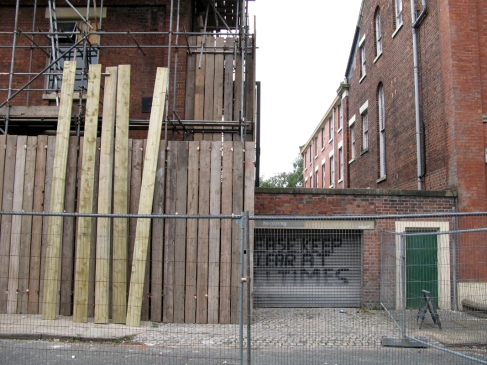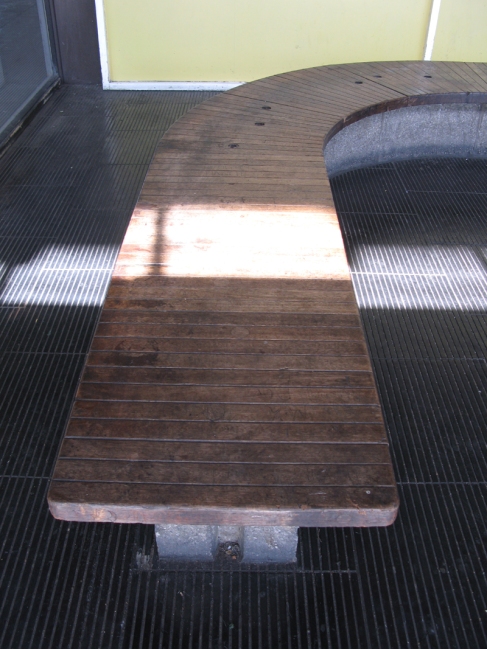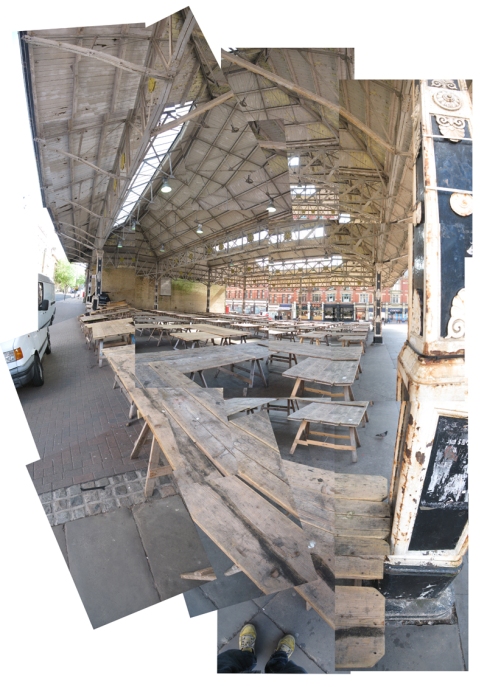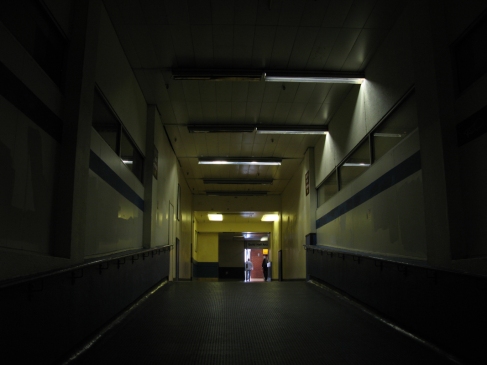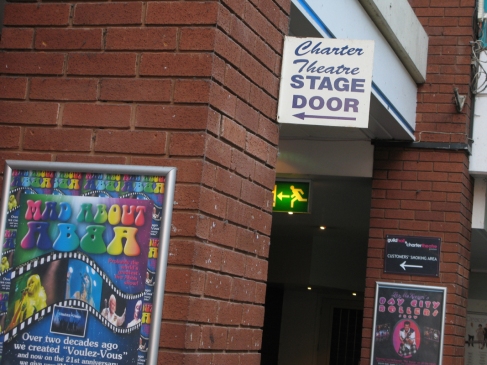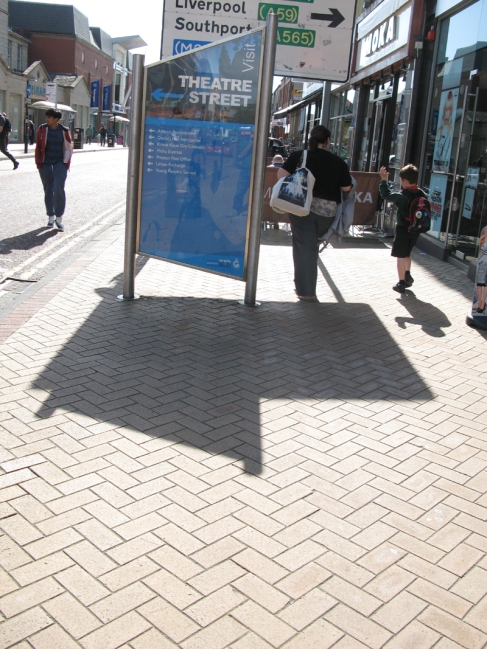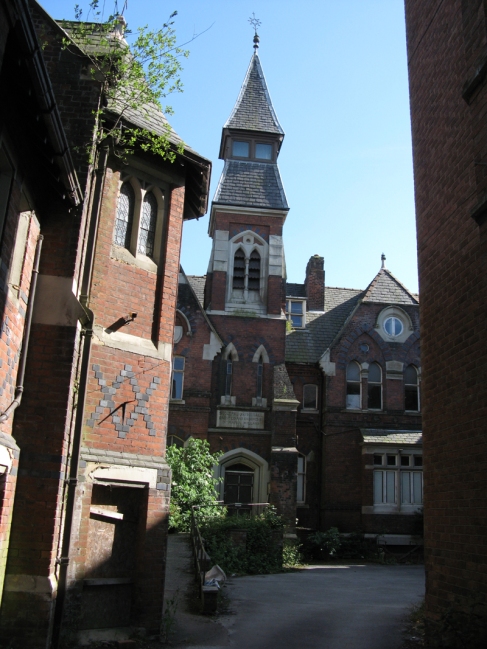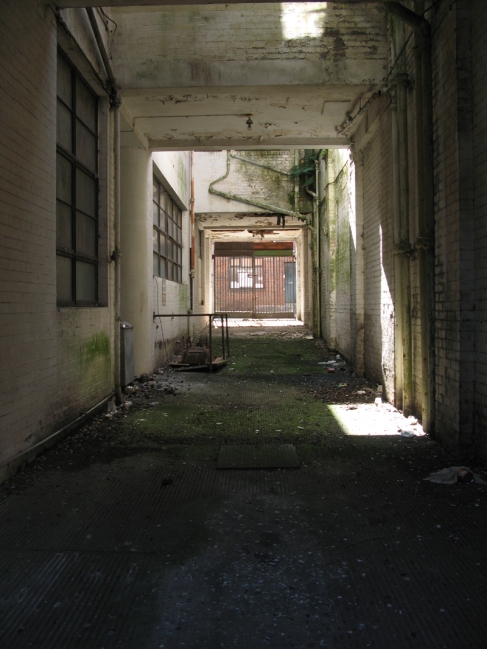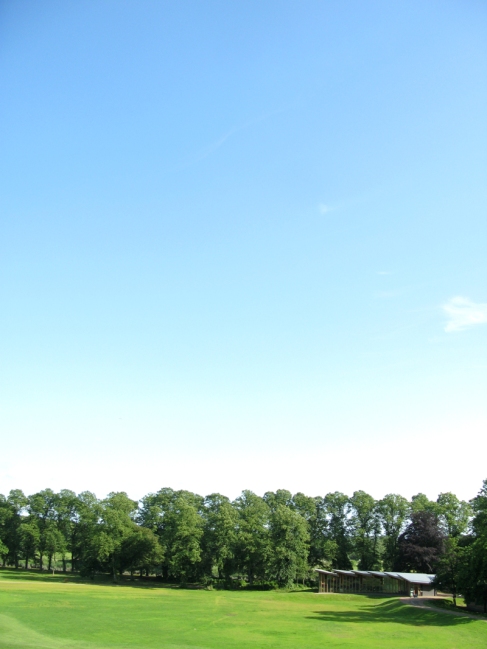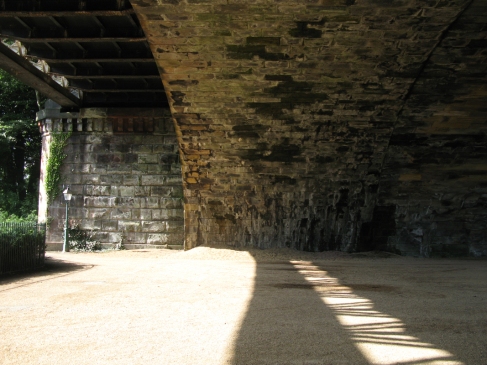As part of the New Theatre in your Neighbourhood project Fuel have been inviting artists to undertake missions to each of the places that we are working in. As part of their mission they will be contributing to this blog. We are delighted to present this mission blog post from Ben Pacey. You can find out more about the New Theatre in your Neighbourhood project at http://www.fueltheatre.com/projects/new-theatre-in-your-neighbourhood
Cycle into Birmingham, bump into friends as I lock my bike up. Run to the ticket machine. A quick ninety minutes – and a coffee – on the train, and here I am.
Preston.
In the sunshine!
This is the city where I was born, and where I lived until I was eighteen. It wasn’t a city then, just a town1. And it’s not like I haven’t been back. My parents still live here, but it’s a long time since I really engaged with the place itself.
My preconceptions of the place, although based on experience, are tangled up with all the rest of my childhood and adolescence. I don’t think that highly of the city, to be honest. But perhaps it’s just teenage angst from 1994?
Whatever. The sun’s shining as I arrive, and I’m looking forward to spending the day here. Let’s go.
Out of the station, and faced with the Fishergate Centre. Terrible graphic design. I skirt round, not through.
Past the army recruitment office on Fishergate. An IRA bomb was disabled in a controlled explosion here in ’91.
The Korova’s just around the corner. The shutters are down, but I see Sam through the door. An (almost brand new!) arts cafe in Preston. I can’t remember what this building used to be. It would probably have been damaged by the explosion, had the bomb gone off. Sam makes me another coffee.
It early days for The Korova, but it’s exciting that it’s here. It’s exciting that Sam, from Essex, has settled in Preston after studying at the University here. We talk about how you grown into a place at university. I think more fondly of Swansea than I do Preston, but they’re probably similar in many ways, although Swansea does have the sea. Sam’s tiny performance studio offers an accessible platform for local writers and performers. Audiences are small, but growing. It’s only been a couple of months.
Artists, perhaps writers in particular, are frustrated in the region, Sam says. They feel excluded from the established venues. It’s hard to engage with the Exchange or the Lowry in Manchester, for example, and the fringe scene there has a patchy reputation.
Sam reckons people in Preston are “laid back”.
It’s time to head to the New Continental.
The bacon sandwich shop on Corporation Street has gone. The guy with the silver beard and ponytail must have been frying pig in there for 30 years. No more. “Steve Tat-2” is still in business.
Five minutes later, West Cliff. Some lovely houses here, just below the railway station.
I wouldn’t have drunk in the Continental when I lived here, but since the refurb I’ve been in a few times, especially now that the Fox and Grapes, on Fox Street, has become a “beach bar”.
In the pub, Chantal. She’s upbeat and enthusiastic. We look at the performance space, which I haven’t seen before. It looks good, bigger than I expected. In a booth by the window, Ruth joins us, and we talk Preston. In a little while, we adjourn to a restaurant on Winckley Square2 for lunch.
It turns out Ruth and I are about the same age, and both grew up in Preston. But we didn’t go to school together. I’m impressed by her choice to return, and by the energy she’s invested here since.
We talk about theatre audiences, or “Guardian-reading culture-seekers” as Ruth, probably accurately, identifies them. They’re not a demographic which Preston is overwhelmed by. Many employees of the university and the council live in Lancaster (quieter, “nicer,” nearer the Lake District) or Manchester, and seek their culture there, not here. With Manchester and Liverpool under an hour away, even those who do live here are probably in the habit of seeking culture (and employment, and shopping) elsewhere. Cursed with a good regional transport infrastructure, perhaps the city is doomed to decline into second-rate dormitory-city status?
I mention Preston Guild. I’d heard good things about last years iteration of this once-every-20-year civic celebration. I’ve heard that it was a brilliant event, and really engendered a positive pride in the city. So I’m surprised by some negative feeling. Here, it seems there’s frustration that the organisers – particularly arts programmers – weren’t able to work with local artists as much as the local artists might have hoped.
But Ruth and Chantal are also frustrated by the local artists, who, I’m told, recently failed to attend Fuel-produced performances at the Continental, in part out of frustration that a platform was being given to artists from out-of-town, rather than themselves.
Lunch done, I suggest that there must be a massive pool of un-used (or under-used) manual skills in the city. I remember Strand Road in the ’80s, then a brick-build industrial gorge, the road cutting between two factories each half a kilometre long. General Electric’s heavy engineering on one side, British Aerospace (BAE Systems) on the other. Today, part of one factory, previously General Electric, is left, as Alstom. The Aerospace site is now all bland housing and a retail park. Ruth, some of whose family sill work for BAE3, reckons I’m a generation late. Those factories closed in the late ’80s, when there would have been a skills surplus4.
Ruth reckons Sam’s description of local people as “laid back” is optimistic.
“They’re apathetic”, she says.
Twenty years ago, it seems to me that people were either charmingly stoic and polite, apathetic verging on hopeless, or viciously frustrated.
Chantal and I head off to meet Sam and Nigel, who work for the council. On the way, we agree that seeing other peoples work is an artist’s responsibility.
We park in Sainsbury’s car park, by the bus station. This brown-brick-block hasn’t been a Sainsbury’s since the ’80s. On the left, the bus station. On the right, and over the footbridge, there’s still a local radio station broadcasting from a converted church.
The bus station!
This place is brilliant. Famously the largest bus station in Europe5. A classic example of brutalist architecture. To me, it’s a dilapidated location for a sci-fi film set in a world where society really values (and funds!) public transport. It’s an epic space. There’s glass, concrete, beautiful timber beams to lean on, and that weird rubbery black flooring which is always slightly sticky. There’s 80 separate bus stands. Stand 33 for bus 33. Stand 35 for bus 35. Both will take you back to my childhood, or at least my parents house. Somehow I can forgive this place for the uncountable hours I must have spend waiting here.
If it were a film set, the orange plastic bucket seats in the cafe would be filled with tourists, thirsty for greasy 50p tea and an authentic taste of their beloved film. Perhaps it’s an atmospheric spy thriller, or a tale of repressed lust exploding into a brutalist brief encounter, or just a quietly moving portrait of everyday northern dignity and stoicism?
In reality, after decades of under-funding, the bus station is on its last legs, and the council is doing its best to be rid of it, despite vocal opposition. Ruth’s been working with architects and artists to develop ideas for restoring and repurposing the structure. Nigel, who’s part of the planning team, doesn’t really want to talk about it. He admits the council wasn’t prepared for furore caused by the announcement of demolition plans.
I chat to Sam and Nigel in the Harris Museum. Just across the foyer, the pendulum6, swinging, has always been there. This is an odd conversation. I can’t quite tell if their language is council bureau-speak, or if they’re being actively evasive. Everything we speak of seems somehow far away. Maybe I’m just in a post-lunch slump?
Briefly boosted for the Guild in 2012, the arts budget, predictably, now leaves everyone under-resourced. But I can’t tell if the arts team are interested in engaging with artists, or not. During the Guild, it seems, someone was employed to communicate with unsolicited contact from artists, who were attempting to engage so vigorously that – at least during 2012 – “we couldn’t just send them all holding emails”. Budgets cut, so presumably the auto-responder is back on.
I’ve just missed the deadline for a project called “Forgotten Spaces”. RIBA, in collaboration with Preston Council, invited proposals for imaginatively re-purposing underused or forgotten urban spaces in the city. There are lots of those, here. The public could apply, but the focus was on professional – or student – architects. It sounds really exciting, but disappointingly, there’s no money to realise any of the competition entries. It’s focus is on raising the city’s profile and attracting development investment. Incidentally, entrants were not permitted to make proposals to reinvent the bus station: “The building remains in use and is therefore ineligible under the competition rules”.
We talk about audiences, and whether Preston has any. The Guild was massively popular, but then it’s only once every 20 years. I’m interested to hear about the Preston Passion7, and Preston Remembers (a heritage event which ran in parallel to the restoration of Preston’s cenotaph) – both of which attracted large audiences and popular engagement. Sam and Nigel identify Preston as being a religious and military city. Anything with a connection to either, they reckon, will be popular here. The “religious” tag I get – this is Priest-town, after all – but I’m surprised by “military”. There’s a small barracks in Fulwood, there’s the aerospace connection, and the un-exploded army recruitment centre. I’m told about archives rich in film footage of soldiers departing by train in 1914.
Conversation over, and I’m free-range.
A quick look around the Harris Museum. The “Discover Preston” exhibition looks contemporary and shiny. Refurbished in time for the Guild, I guess. A handful of kids are hanging out here. They avoid me. Upstairs, I’m impressed by a temporary exhibition of video art called “Workplace”. It doesn’t feature any local artists, so far as I can tell.
Back out in the sunshine.
The town centre’s struggling. An influx of charity shops.
The (beautiful) outdoor covered market is hanging on. On days when there’s no market, or car-boot, it’s a brilliant covered space for “outdoor” events and spectacle. It recently sheltered Preston Mela – usually held in one of the parks – from the rain. The larger of the two spaces reminds me of the warehouses in Nantes where Les Machines De L’Ile are based. I hear a rumour that the council want to sell these spaces for redevelopment.
I’m told that the indoor market is thriving, but I don’t visit. Incongruously, in a run-down arcade, piped radio reports that J-Lo has caused international controversy by performing in Turkmenistan.
I pass back through the bus station to take some photos. The pedestrian underpasses are empty. I remember them bustling, and choked with cigarette smoke.
It’s now 5pm on a Monday, and the Guild Hall is also deserted. And stuck in the 1970s. Not just the building, even the programming. It doesn’t look like anyone thought to spruce this place up for the 2012 Guild.
I spotted Theatre Street earlier, and want to check it out. The highlight is the derelict orphanage, one of the “Forgotten Spaces” from the RIBA project. I’ve never noticed this massive building before. It’s hard to imagine it revitalised as an arts or workspace complex. So much money! Perhaps the university could do something with it? More likely apartments, if it’s still here when the economy picks up.
I head to Avenham Park. Ten minutes from the city centre, it’s green and amazing, especially in the sunshine. The grass slope rolls down into a massive amphitheatre, with a tree-lined avenue and the river as a backdrop. The damp hulking concrete “bandstand” which I remember has gone, replaced by a new cafe. It’s all sleek timber and exposed architecture. But disappointing as a cafe, I hear.
The adjoining Miller Park looks amazing. Another Guild year transformation, perhaps? Hope there’s budget left for upkeep, but both parks look brilliant today.
As I re-approach the New Continental, I’m intrigued by a strange space beneath the railway arches.
Pass the pub this time. Following the river, I soon diverge to walk down Strand Road.
I could visit the docks, now surrounded by apartments, retail and offices. I don’t.
Under the railway again, swallows swoop low over the canal, catching flies. Tea time. I head home.
Notes
1. City status was awarded in 2002 as part of the Queen’s Golden Jubilee.
2. A gorgeous rolling tree-lined square, just back from the high street (Fishergate), and enclosed by mostly original Georgian town-houses (now offices). Unfortunately, there’s no view out from the basement restaurant(!).
3. One of my family’s next-door neighbours, a skilled carpenter, would have been part of this generation. A skilled carpenter, he was mostly unemployed through the ’90s, which would have been the final decade of his career. His son runs a small one-man-band furniture and upholstery business, rather than making timber formers for aircraft wings.
4. BAE Systems is still a significant employer in Preston, manufacturing military aircraft at two out-of-town sites at Samlesbury and Warton.
5. Although, according to Wikipedia, “some claim that it is the second largest bus station in Western Europe”. So maybe I was duped.
6. Wikipedia tells me it’s a Foucault Pendulum, which acts as a “reasonably-accurate” clock, thanks to the rotation of the earth.
7. According to the BBC, the Preston Passion was “a ground-breaking live event marking Good Friday with a contemporary and ambitious exploration of the Passion story. A unique combination of spectacular mass participation performance and three original recorded dramas based in Preston past and present, drawing on the enduring universal themes of the story of Christ’s condemnation and crucifixion.”
